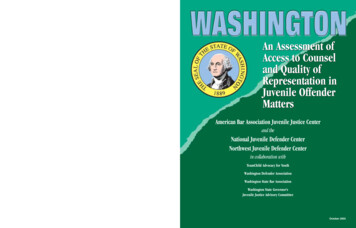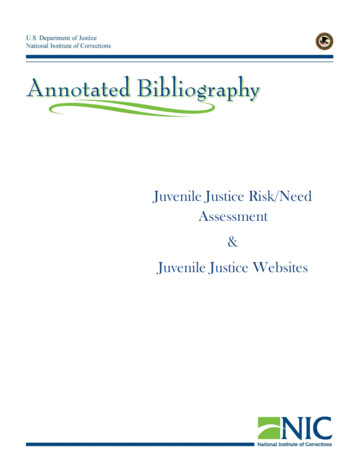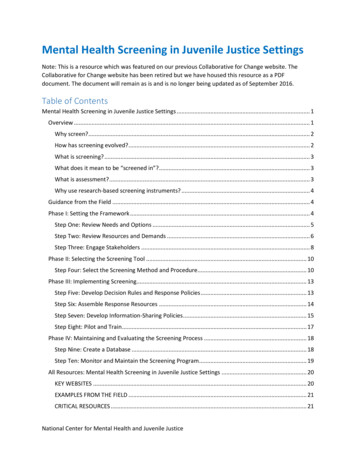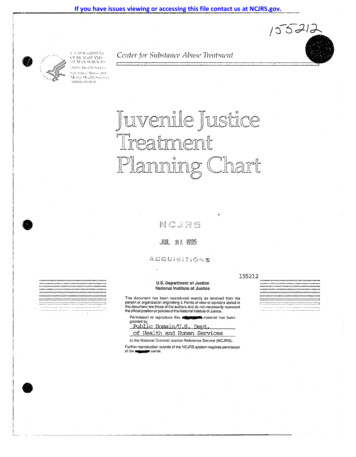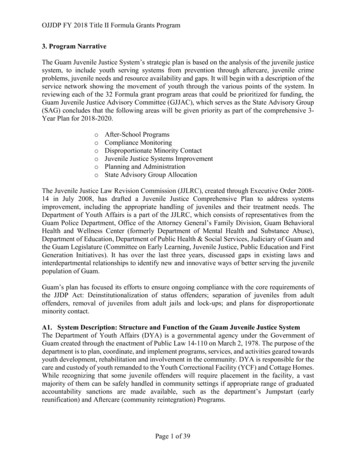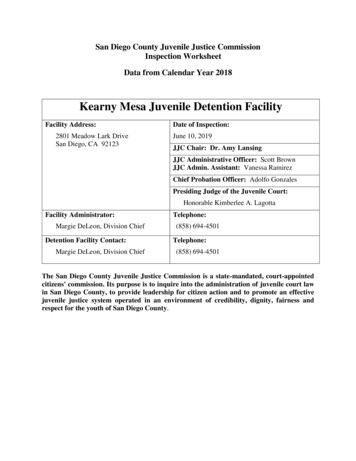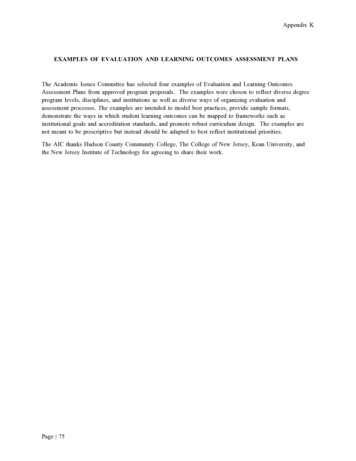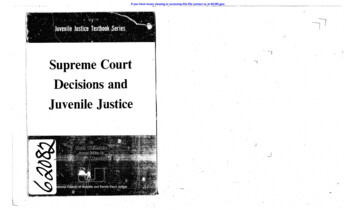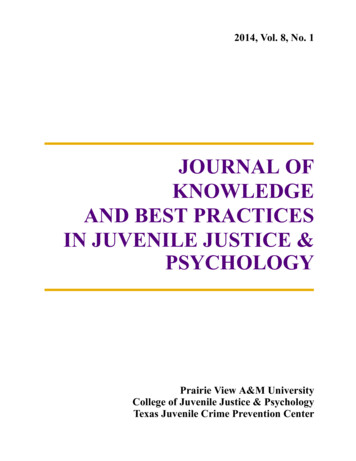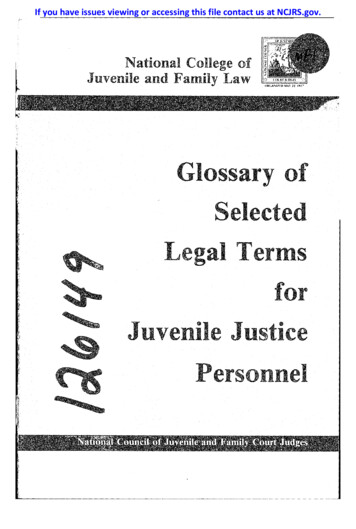
Transcription
ASSESSMENT OF JUVENILE JUSTICEREFORM ACHIEVEMENTSIN THE FORMER YUGOSLAVREPUBLIC OF MACEDONIAUNICEF Regional Office for Centraland Eastern Europe/Commonwealth of Independent StatesOctober 2010This project is funded by theEuropean UnionThis project is co-funded andimplemented by UNICEF
ASSESSMENT OF JUVENILE JUSTICE REFORM ACHIEVEMENTS IN THE FORMER YUGOSLAV REPUBLIC OF MACEDONIACONTENTSNote on the Assessment Mission.3Background .4Executive Summary .5PART I. The Process of Juvenile Justice Reform .81.Policies and strategies .82.Law reform .93.Administrative reform/restructuring .114.Allocation of resources .115.Training and capacity-building .116.Accountability mechanisms . 137.Coordination . 138.Data and research . 14PART II. The Juvenile Justice System in The former Yugoslav Republic of Macedonia . 171.Prevention . 172.The residential centre for children and youth with educational and social problems . 183.Policing, the investigation of offences and pretrial detention . 194.Diversion . 225.Mediation . 236.The adjudication of juveniles . 247.Dispositions and sentencing . 288.The treatment of juvenile offenders in closed facilities . 329.General concerns regarding correctional facilities for juveniles . 3710. The procedure for underage offenders and diversion . 3911. The role and capacity of the Centres for Social Work . 41PART III. UNICEF’s Support to Juvenile Justice Reform . 44PART IV. Conclusions and Recommendations . 45POSITIVE DEVELOPMENTS . 45CHALLENGES . 47RECOMMENDATIONS . 50Annex 1. Data collection and analysis. 55Annex 2. List of persons interviewed . 61Annex 3. List of documents consulted . 63Annex 4. Comments on the draft amendments tothe Law on Juvenile Justice and related matters . 662
ASSESSMENT OF JUVENILE JUSTICE REFORM ACHIEVEMENTS IN THE FORMER YUGOSLAV REPUBLIC OF MACEDONIA“If you violate a child’s rights even once, it will be hard to repair the damage.”– President of the national bar association“A law is not a good law if it can’t be implemented.”– Coordinator of a CSW juvenile justice teamNote on the Assessment MissionThe assessment mission took place from 17 to 28 May 2010. The team consisted of Dan O’Donnell,international consultant, and Marina Kovacic, national consultant. Support was provided by BiljanaLubarovska and Olimpija Grozdanovska of UNICEF.The team interviewed the President of the State Council for Prevention of Juvenile Delinquency, theDirector of the Institute for Development of Social Work, the Head of the Human Rights Departmentof the Ministry of Justice, the Director of the Department of Execution of Sanctions, the Head ofthe Alternative Measures Section, the Deputy Ombudsperson responsible for children’s rights,the Advisor on Juvenile Justice of the Ministry of Labour and Social Policy, and the Director of theAcademy for Training of Judges and Public Prosecutors.The team met with the President of the Basic Court 1 in Skopje, the two juvenile judges, aninvestigating judge and two prosecutors attached to that court, as well as the juvenile justice team ofthe Inter-Municipal Centre for Social Work (CSW) in Skopje, the team of police investigators in Skopjespecialized in juvenile cases, and another juvenile judge.Visits were made to the juvenile prison in Ohrid, the educational-correctional institution for juvenileoffenders located in Skopje prison, the pretrial detention unit of the Skopje prison, the women’sdepartment in Idrizovo prison, the open educational facility ‘Ranka Milanovic’, and the openresidential centre for children at risk, known as ‘25 th May’.Meetings were also held with the presidents and other representatives of the Association ofMediators and the national bar association, a representative of the Organization for Securityand Co-operation in Europe (OSCE), a representative of the local branch of the Helsinki Committeefor Human Rights and a professor of the Institute of Social Work and Social Policy of theUniversity Saints Cyril and Methodius as well as the co-director and project coordinator of the Centrefor Human Rights and ConŃict Resolution, an NGO.The lists of persons interviewed and documents consulted are attached (see Annexes 2 and 3).In July 2010, the assessment team prepared a memorandum concerning certain draft amendments tothe Law on Juvenile Justice that it considers incompatible with the rights of children, and provisionsof the Law that it believes should be amended to bring them into greater harmony with internationalstandards on juvenile justice. The text of the memorandum, which was forwarded to the Ministry ofJustice, can be found in Annex 4 to this report.1Basic courts are trial courts, i.e., courts of łrst instance, having competence over a wide range of cases(e.g., criminal, civil etc.).3
ASSESSMENT OF JUVENILE JUSTICE REFORM ACHIEVEMENTS IN THE FORMER YUGOSLAV REPUBLIC OF MACEDONIABackgroundIndependence from Yugoslavia was declared in 1991, and was obtained without armed conflict. In2001, however, a short-lived insurgency broke out in western and northern parts of the country.The population is 2.04 million, of which 469,000 (23 per cent) are below 18 years of age. 2Some 25 per cent of the population is ethnic Albanian, and other ethnic minorities (including Turks,Roma and Serbs) make up another 10 per cent. 3The former Yugoslav Republic of Macedonia became a Member State of the United Nations in 1993and of the Council of Europe and OSCE in 1995, and a candidate for accession to the European Unionin 2005.It became a State party to the Convention on the Rights of the Child in December 1993, by succession. 4UNICEF established an office in 1993. In 2006, the Government adopted a second National ActionPlan on Children’s Rights (2006–2015), and a National Committee on the Rights of the Child wasestablished in 2007. 5The first report on the implementation of the Convention on the Rights of the Child was examinedby the Committee on the Rights of the Child in 2000, and the second report was considered duringthe assessment mission. After examining the second report, the Committee expressed concernabout poor conditions, including overcrowding, in the educational-correctional institution and inthe juvenile prison in Ohrid, about the compulsory drug testing of juvenile prisoners and about theconfinement of juveniles and adults in the same facilities. 6The number of ‘reported’ juvenile offenders increased during the years immediately followingindependence, but fell by more than half from 1992 to 2002.7 Since then, it has fluctuated intwo-year cycles: in 2008, it was 1,355 offenders, far lower than any year from 1986 to 2000. 8 In 2009,it increased to 1,519 offenders. 9 Similarly, data on the number of convicted juvenile offenders show adecrease of 36 per cent from 1995 to 2009.1042UNICEF, The State of the World’s Children 2010, UNICEF, New York, 2009, Tables 1 and 6.3State Statistical Office, Table: Total Population of the Republic of Macedonia by ethnic affiliation and region, Census ofpopulation and households 2002, available at www.stat.gov.mk, accessed 1 October 2010.4United Nations Treaty Collection, Database on the Status of Treaties, Chapter IV.5A committee of the same name was established in 2001, but did not become operational.6Committee on the Rights of the Child, Consideration of reports submitted by States parties under Article 44 of theConvention, Concluding Observations on the second periodic report of The former Yugoslav Republic of Macedonia,CRC/C/MKD/CO/2, 2010, para. 79. (The Committee also expressed concern about practices that appear to have beendiscontinued, or that the assessment team saw no evidence of, such as solitary confinement, corporal punishment, theapplication of correctional measures by the Centres for Social Work, and treating juvenile offenders as adults [paras. 38and 79].)7Number of reported juvenile offenders: 1,809 in 1990; 2,668 in 1992; 1,266 in 2002. See Arnaudovski, L., Chacheva, V., andChoneva, L., Efficiency of Measures in the Juvenile Justice System, Institute of Sociological, Political and Juridical Researchand UNICEF, Skopje, 2004, p. 64. (Reported offenders include those not prosecuted as well as those prosecuted, whether ornot they were convicted.)8State Statistical Office, Perpetrators of Criminal Offences in 2008, Skopje, 2009, p. 106.9State Statistical Office, News Release No. 2.1.10.24, 13 July 2010, p. 7.10From 1,184 in 1995 to 748 in 2008. See Efficiency of Measures, supra, p. 70 and News Release, supra, p. 8.
ASSESSMENT OF JUVENILE JUSTICE REFORM ACHIEVEMENTS IN THE FORMER YUGOSLAV REPUBLIC OF MACEDONIAExecutive SummaryThe structure of the juvenile justice system that existed at independence, in 1991, was similar insome respects to the system that exists today. There were no juvenile courts, but there were judgesand prosecutors specialized in cases involving children and accused juveniles. There were policeofficers having special responsibility for matters involving children, including offending by juveniles.There was a special prison for older juveniles convicted of an offence, a closed ‘educationalcorrectional’ facility for juveniles who committed offences while aged 14–18 years, and two facilitiesunder the Ministry of Labour and Social Policy: an open facility for convicted juvenile offendersand a residential facility for children at risk. The Criminal Code and the Code of Criminal Procedurecontained sections applicable to accused juveniles and the sentencing of convicted juveniles. Theminimum age for prosecution as a juvenile offender was 14 years, and no one was prosecuted asan adult for offences committed while under age 18. There was no procedure for diverting accusedjuveniles from adjudication, however, and no lawyers specialized in the defence of accused juveniles.Reported offending by juveniles increased immediately after independence, but fell by more thanhalf from 1992 to 2002. Since then it has fluctuated, without a significant upward or downward trend.A situation analysis prepared during the 1990s led to a national seminar in 2000 that adopted anumber of recommendations, including one calling for the adoption of a law on juvenile justice. In2003, the Ministry of Justice convened a working group to draft the law on juvenile justice, andin 2004 three studies by national experts intended to inform the law were published. The Law onJuvenile Justice was finally adopted in 2007, and came into force in 2009. The government adoptedan Action Plan for Implementation of the Law on Juvenile Justice that coincided, to a large extent,with the period between the adoption of the law and its entry into force. About half the activitiesenvisaged by this plan were carried out. A new plan covering the period 2009–2012 was adoptedsubsequently.The law established a State Council for Prevention of Juvenile Delinquency, which was appointed in2009. The Council has adopted a work plan covering 2009–2012.Other changes introduced by the Law on Juvenile Justice include the following:sthe introduction of diversion, a non-judicial procedure for the resolution of minor cases;sthe introduction of a sentence of attendance in a community-based rehabilitation centre/placement for no more than 20 days;sthe requirement that a lawyer be present during the questioning of juvenile suspects;svictim-offender mediation;slimits to the duration of investigative and judicial proceedings;srequirements on the training of specialized judges, prosecutors, police investigators, defenceattorneys and mediators, and a requirement that the Centres for Social Work (CSWs) establishspecialized departments or teams.Many of the changes introduced by the law have not yet been implemented in practice, however. Themunicipal councils for the prevention of offending mandated by the law have not been established.The community-based rehabilitation centre is still not operational. Mediation is not yet beingpractised. At the time of the assessment mission, lawyers were not attending questioning of juvenilesuspects because arrangements for payment of their fees have not been agreed. A fund for thecompensation of child victims has not yet been set up.5
ASSESSMENT OF JUVENILE JUSTICE REFORM ACHIEVEMENTS IN THE FORMER YUGOSLAV REPUBLIC OF MACEDONIAAt this writing, the law has been in force a little over a year, and it appears likely that some ofthese shortcomings will be overcome in the next year or so. Financial constraints have affected theimplementation of the law and, more generally, the development of juvenile justice. The assessmentteam also concludes that political commitment, while strong in some sectors, is insufficient in others.In addition, a few provisions of the new law risk being repealed. Judges and prosecutors areadvocating relaxation of time limits, and the CSWs object to the mandatory participation of lawyersin diversion proceedings.The assessment team believes that the provision of the new law concerning the diversion of minorcases to the CSWs is positive, in principle, but that consent to diversion should be required and theright of the offender to legal assistance should be maintained.Progress has been made in training. Training for judges, prosecutors and correctional staff has beeninstitutionalized. Considerable training of CSW staff also has been done, and a useful independentevaluation has identified areas where improvements are needed.Progress has been achieved in the publication of data on offending by juveniles, and on juvenile justiceand corrections. Valuable research has been carried out and is being conducted by independent,non-governmental institutions and organizations.Some improvements in juvenile justice were made prior to the adoption of the new law. Policeinspectors specialized in the investigation of crimes by and against children have been trained andassigned throughout the country. There is wide agreement that the level of physical violence bypolice against juveniles is very low. The population of the open residential centre for children atrisk decreased by more than half since independence, due to changes in policy that now emphasizetreatment in the family and placement only as a last resort.Some positive developments are independent of the new law. Programmes for assisting the parentsof juvenile offenders and children at risk are being piloted. A Deputy Ombudsperson in charge ofchildren’s rights monitors the situation of children in residential facilities. Unfortunately, the impactof these initiatives seems limited, to date. For example, there has been no official reply to reports bythe Office of the Ombudsman concerning abuse of children in two facilities operated by the Ministryof Labour and Social Policy.One particularly negative change also took place: the transfer of the educational-correctionalinstitution to the grounds of a prison for adults. This was triggered by events beyond the control ofthe government, but the temporary solution that violates the rights of the juvenile population hasbeen allowed to continue for some nine years. A new temporary solution was agreed on after theassessment mission – transfer of this unit to the grounds of an open prison for adults and transfer ofthe adult population to other prisons.Other concerns about correctional and detention facilities include the appointment of directors with noprofessional qualifications, the weakness of rehabilitation methods, the emphasis on work that is notdesigned primarily to facilitate rehabilitation and reintegration, the absence of standards on the careof juveniles in pretrial detention, weak links between residential facilities and the community, and theabsence of programmes to assist prisoners after release. The lack of capacity of the CSWs, which havea large and multifaceted role in the juvenile justice system, is also one of the most important concernsof the assessment team. Other important concerns include the weakness of secondary prevention,and the lack of prevention and rehabilitation efforts that take into account the special needs of theRoma community, which is greatly over-represented in the correctional facilities for juveniles.6
ASSESSMENT OF JUVENILE JUSTICE REFORM ACHIEVEMENTS IN THE FORMER YUGOSLAV REPUBLIC OF MACEDONIAThe recommendations made by the assessment team include:sschool- and community-based prevention should be strengthened;snew standards on the treatment of juveniles in pretrial detention should be adopted;sthe right of the child to be heard in diversion proceedings should be recognized expressly andthe role of his/her attorney clarified;sresponsibility should be defined for the payment of lawyers’ fees for representing childrenduring the investigative stage of proceedings;sthe right to free victim-offender mediation should be recognized;spriority should be given to the establishment of the community-based rehabilitation centre;smore effective methods of rehabilitation in correctional facilities for juveniles should beintroduced and steps taken to ensure that work by prisoners meets international standards;sthe policy of allowing young adults to remain in juvenile facilities should be revised to ensurethat the best interests of prisoners under age 18 are the main concern;smerit-based standards should be adopted for the appointment of directors of correctionalfacilities and standards for monitoring the finances of such facilities should be more transparent;sindicators for data on offending and the functioning of juvenile justice should be reviewed andresearch undertaken on ‘what works’ in the prevention of offending and reoffending.7
ASSESSMENT OF JUVENILE JUSTICE REFORM ACHIEVEMENTS IN THE FORMER YUGOSLAV REPUBLIC OF MACEDONIAPART I. The Process of Juvenile Justice Reform1. Policies and strategiesNo national strategy on juvenile justice has been adopted. However, some plans and strategiesrelated to juvenile justice have been adopted or are in the process of development.The National Action Plan on Children’s Rights (2006–2015) contains a component on prevention, called“Development of a Comprehensive Approach to the Protection of Children with Upbringing-SocialProblems and Behaviour Problems.” It envisages 10 activities to be carried out by the Ministry ofLabour and Social Policy, the Ministry of the Interior, the Ministry of Justice and the Ministry of LocalSelf-Government. They include the creation of a network of community-based ‘day-care centres’ forthe protection of children at risk, training in the identification of children at risk and support for parentswho neglect their children. The reduction of offending by juveniles is expressly recognized as an aimand indicator of the implementation of the Action Plan. Strategic considerations include strengtheningthe capacity of the relevant institutions, developing standards and procedures for interdepartmentalcooperation at national and local levels and collaboration with NGOs. Some of these activities havebeen or are being carried out (see the sections on training and on prevention, below).The Law on Juvenile Justice adopted in 2007 provides for a State Council for Prevention of JuvenileDelinquency, whose mandate includes the preparation of a strategy for the prevention of juveniledelinquency. The creation of the State Council in November 2009 represents an important step in theimplementation of this component of the National Action Plan on Children’s Rights.After the Law on Juvenile Justice was adopted in 2007, the Ministry of Justice prepared an ActionPlan and a budget framework for the implementation of the Law on Juvenile Justice for 2008–2009.Eighteen months of this period formed part of the two-year vacatio legis between adoption of thelaw and its entry into force and implementation on 30 June 2009.11 The Action Plan included some30 activities, of which roughly half were accomplished. Most of the activities carried out concernedtraining or the adoption of ‘secondary legislation’ – regulations, guidelines and the like. Activities notaccomplished include the establishment of a ‘disciplinary centre’ for the rehabilitation of offenderswith emphasis on community-based treatment, the relocation of the educational-correctionalinstitution now located within the grounds of a prison, the creation of child-friendly rooms in CSWs,the definition of the parameters and procedures of a database on children at risk and offenders, andmaking certain amendments to the Law on Juvenile Justice.A second Action Plan for Implementation of the Law on Juvenile Justice covering the period2009–2012 has been adopted. It reaffirms the commitment to implement some of the activities notaccomplished during 2008–2009, such as relocating the educational-correctional institution andestablishing a community-based centre for diversion measures and alternative sentences.12 Otheractivities are redefined in more concrete terms. Examples include the establishment of 10 municipalcouncils for the prevention of juvenile delinquency, the consolidation of a pilot project for parents ofjuvenile offenders and children at risk and its expansion to other communities, the development ofstandardized programmes for the treatment of specific groups of juveniles in closed facilities, andthe preparation of the national strategy for prevention of juvenile delinquency.811In The former Yugoslav Republic of Macedonia the term equivalent to ‘entry into force’ has a different meaning than it doesin English and many other languages, referring to the point at which it is irrevocably incorporated into the national legalsystem, even if it is not binding at that time. In this report, intended mainly for an international readership, the term ‘entryinto force’ is employed with its accepted meaning in the English language.12Referred to by the legislation as ‘disciplinary centre’.
ASSESSMENT OF JUVENILE JUSTICE REFORM ACHIEVEMENTS IN THE FORMER YUGOSLAV REPUBLIC OF MACEDONIAThe second Action Plan for Implementation of the Law on Juvenile Justice (2009–2012) is a goodone, in the sense that the activities are all relevant and needed. However, it seems too ambitious toaccomplish in two years, especially given the experience of the 2008–2009 Action Plan.Since the Action Plan by definition aims to implement the Law on Juvenile Justice, which establishedthe State Council for Prevention of Juvenile Delinquency and defined its mandate, it is inevitable that itoverlaps with the mandate of the Council. However, neither the Council nor any other interministerialor intersectoral body has a mandate to coordinate the implementation of the Action Plan as such. TheCouncil has adopted a five-year work plan and an annual work plan for 2010.A strategy or plan for the rehabilitation of the prison system was developed recently, with thehelp of OSCE. The project includes the development of programmes for specific groups ofprisoners, including drug addicts, sex offenders and juveniles. A 46 million loan from the Councilof Europe Development Bank for the development of infrastructure was announced in May 2010.The construction of a separate and entirely new educational-correctional institution for convictedjuveniles with a capacity of 84 persons is one of the four main components of the plan.The creation of this urgently needed facility was envisaged in the Action Plans for Implementationof the Law on Juvenile Justice, as indicated above, and the incorporation of this component is avery positive development. The decision to build a facility with more than twice the capacity of thepopulation confined in the existing institution at any time since 2001 does, however, seem out ofharmony with the emphasis on prevention in other strategies, and the emphasis on diversion andalternative sanctions in the Law on Juvenile Justice.In conclusion, there is a tendency to approach the development of juvenile justice strategically, andthe Action Plans prepared have identified relevant objectives and activities. They have also helped togenerate and maintain a degree of momentum, although thus far they do not appear to have createdthe political commitment necessary for their satisfactory implementation, and the short-term planshave also been somewhat overly
the number of 'reported' juvenile offenders increased during the years immediately following independence, but fell by more than half from 1992 to 2002.7since then, it has fluctuated in two-year cycles: in 2008, it was 1,355 offenders, far lower than any year from 1986 to 2000.8in 2009, it increased to 1,519 offenders.9similarly, data on the
